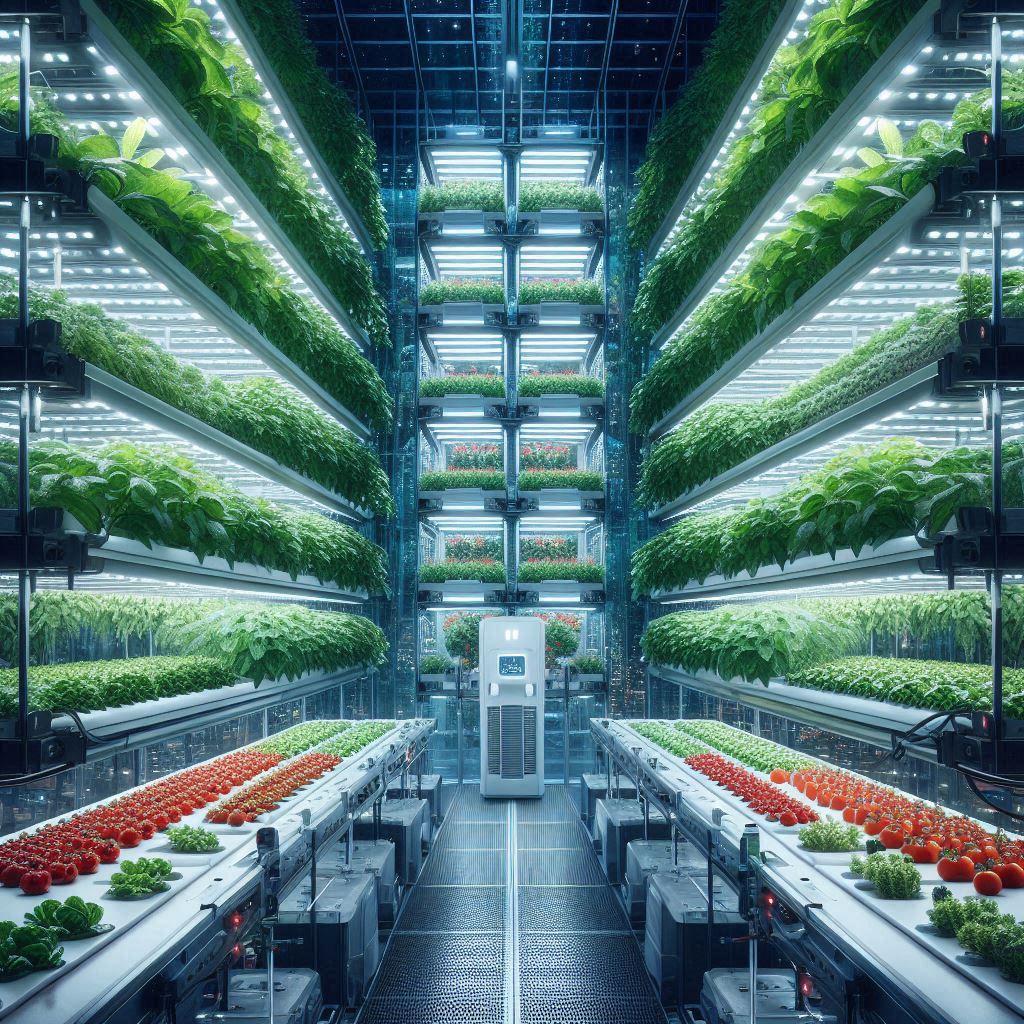The vertical farming industry is rapidly gaining traction as a sustainable solution to meet the global demand for food production amidst increasing urbanization and diminishing arable land. With technological advancements, vertical farming is reshaping agriculture by optimizing land use and minimizing water consumption. This article explores the trends shaping the future of vertical farming, market growth projections, key players, regional outlook, opportunities, challenges, and industry segmentation.
Trends Shaping the Future of Vertical Farming Industry
- Automation and AI Integration: The integration of artificial intelligence, machine learning, and robotics into vertical farming systems is revolutionizing crop management. Automated systems monitor environmental conditions and crop health in real-time, optimizing growth cycles and maximizing yields.
- Sustainable Farming Practices: Vertical farming’s reliance on hydroponics, aquaponics, and aeroponics allows for water-efficient and pesticide-free cultivation. This aligns with the global push toward more sustainable and eco-friendly agricultural practices, significantly reducing the environmental impact.
- Urban Agriculture Expansion: As cities become more populated, vertical farms in urban centers are growing, reducing transportation costs, and ensuring fresh, local produce. This trend supports the rise of farm-to-table initiatives and urban self-sufficiency.
- Genetically Optimized Crops: Advances in plant genetics are leading to the development of crops specifically designed for vertical farming. These crops are optimized for higher yields, faster growth rates, and enhanced nutrient profiles.
- Energy Efficiency Innovations: Energy remains a key cost driver in vertical farming. Innovations in LED lighting, solar energy, and renewable energy sources are helping reduce the energy footprint of vertical farms, making them more economically viable.

Vertical Farming Market Growth Projection
The global vertical farming market is expected to grow significantly in the coming years. According to market forecasts, the global vertical farming market was valued at USD 5.6 billion in 2024 and is projected to reach USD 13.7 billion by 2029; it is expected to register a CAGR of 19.7% during the forecast period. This growth is driven by increasing consumer demand for fresh, locally sourced produce, advancements in farming technologies, and the urgent need to address food security.
Top Companies in the Vertical Farming Industry
- AeroFarms: A leading vertical farming company, AeroFarms specializes in aeroponic technology to grow crops without soil. Their state-of-the-art facilities are highly efficient and environmentally sustainable.
- Plenty: Known for its high-tech, indoor vertical farms, Plenty uses robotics and AI to enhance crop production and reduce water consumption.
- Bowery Farming: Bowery’s smart farms use vertical farming and automation to produce pesticide-free crops in urban environments.
- Infarm: Headquartered in Europe, Infarm is recognized for its modular farming units, which are implemented in grocery stores, restaurants, and urban locations.
- Kalera: Kalera is one of the largest vertical farming companies specializing in hydroponic lettuce and leafy greens production for supermarkets and food service industries.
Regional Analysis
- North America: The North American vertical farming market is witnessing robust growth, primarily in the U.S. and Canada, due to favorable government policies, technological advancements, and growing consumer awareness about sustainable farming.
- Europe: Europe is another key region driving the adoption of vertical farming, particularly in countries such as the Netherlands, the UK, and Germany. The region’s strong focus on sustainability and food security is accelerating the growth of vertical farms.
- Asia-Pacific: The Asia-Pacific region, led by countries like Japan, Singapore, and China, is a significant market for vertical farming. High population density, limited arable land, and food security concerns are driving investments in urban agriculture.
- Middle East and Africa: The Middle East is emerging as a potential market for vertical farming, with countries like the UAE and Saudi Arabia investing heavily in sustainable farming methods to combat food scarcity in desert regions.
Opportunities in the Vertical Farming Industry
- Technological Advancements: Continuous innovations in AI, IoT, and energy-efficient systems present significant growth opportunities for the vertical farming industry.
- Government Support: Government initiatives aimed at promoting sustainable agriculture and reducing reliance on food imports offer strong growth prospects.
- Urbanization and Food Security: As urban populations increase, vertical farming will play a crucial role in providing fresh, healthy produce to city dwellers while reducing the carbon footprint of food transportation.
- Sustainable Supply Chains: Vertical farming presents an opportunity for the food supply chain to become more sustainable and resilient, addressing concerns over food scarcity and climate change.
Challenges Facing the Vertical Farming Industry
- High Initial Investment Costs: One of the main challenges of vertical farming is the high initial capital required for setting up and operating farms, especially when it comes to energy, lighting, and automation technology.
- Energy Consumption: While innovations in energy efficiency are on the rise, energy consumption remains a key cost driver for vertical farms, particularly in regions where electricity is expensive.
- Limited Crop Variety: Vertical farming is currently more suitable for leafy greens, herbs, and certain fruits. Expanding the range of crops that can be effectively grown in vertical farms is an ongoing challenge.
- Regulatory Hurdles: In some regions, vertical farming faces regulatory challenges related to land use, building codes, and food safety standards.
Vertical Farming Industry Segmentation
- By Technology:
- Hydroponics
- Aeroponics
- Aquaponics
- By Structure:
- Building-Based Vertical Farms
- Shipping Container Vertical Farms
- By Crop Type:
- Leafy Greens (Lettuce, Spinach)
- Herbs (Basil, Mint)
- Fruits (Strawberries, Tomatoes)
- Flowers
- By Region:
- North America
- Europe
- Asia-Pacific
- Middle East & Africa
- Latin America
The future of the vertical farming industry is bright, with numerous opportunities for growth driven by technological advancements, sustainability trends, and the increasing demand for locally grown, fresh produce. While challenges such as high energy costs and regulatory barriers remain, continued innovation in AI, automation, and energy efficiency will enable the industry to overcome these hurdles. As vertical farming expands globally, it will play an essential role in addressing food security and supporting urban populations.